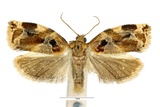Archips xylosteana (Linnaeus, 1758) Species
Last modified: Oct. 2, 2025, 1:40 p.m.
A common species throughout Belgium.
Details
- Classification
- Family: Tortricidae > Subfamily: Tortricinae > Tribus: Archipini > Genus: Archips > Species: Archips xylosteana
- Vernacular names
- Gevlamde bladroller (NL), Variegated Golden Tortrix (EN), Aprikosenwickler (DE)
- First mention in Belgium
- De Sélys-Longchamps E. 1844. Énumération des insectes Lépidoptères de la Belgique. — Mémoires de la Société royale des Sciences de Liége 2: 1–35. On page 20.
- Status
-
Native
Distribution
Imago
Wingspan 15–23 mm. Forewing ground color is pale pinkish brown. Forewing markings are dark reddish brown and include a basal patch and a well-defined median fascia that is narrow at the costa and broadened at the dorsum. The subterminal fascia gives the appearance of a costal spot on many individuals. Hindwings are grayish brown. Males have a forewing costal fold.
Caterpillar
Last instar larvae are greenish gray to whitish gray. The head and prothoracic shield are black or dark brown and are separated by a white line. Thoracic legs are dark brown or black.
Bionomics
The eggs are oviposited in small batches under a brownish secretion on the bark of a great variety of deciduous trees. The species hibernates in the egg stage.
The caterpillar lives in a rolled leaf and pupation takes place in this larval habitation.
The adults fly from sunset and come to light.
Flight periods
The adults usually fly from the beginning of June till the end of July, occasionally later.
Observed on
- Substrates:
- Polyphagous
The larvae live on the bark of a great variety of deciduous trees, but also on Abies, Rubus, Lonicera or Hypericum.
Habitat
It inhabits gardens and wooded areas.




